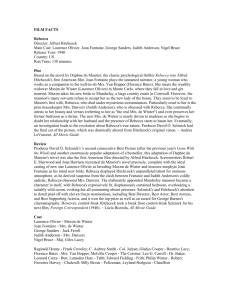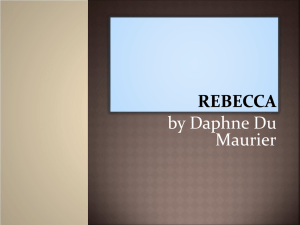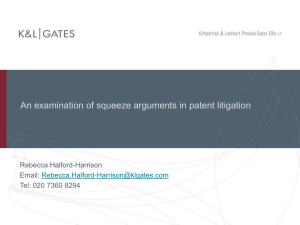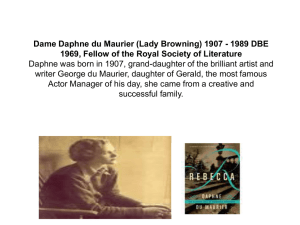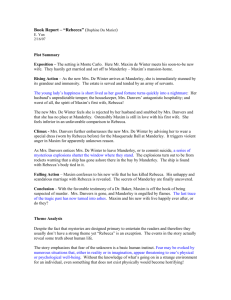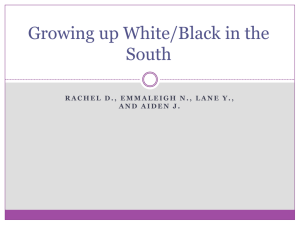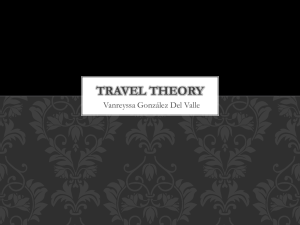Rebecca (1940 and 1997)
advertisement
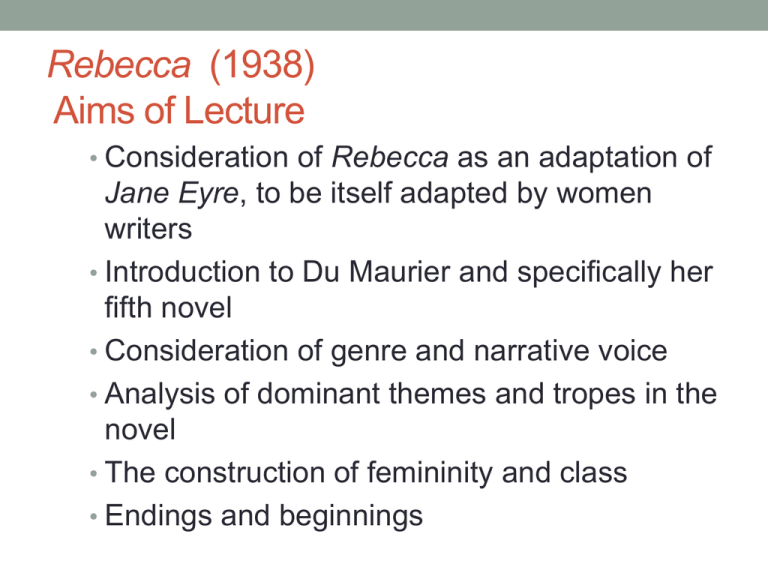
Rebecca (1938) Aims of Lecture • Consideration of Rebecca as an adaptation of Jane Eyre, to be itself adapted by women writers • Introduction to Du Maurier and specifically her fifth novel • Consideration of genre and narrative voice • Analysis of dominant themes and tropes in the novel • The construction of femininity and class • Endings and beginnings Literary Heritage • Homage to Jane Eyre (1847), complete with spectre of first wife, Grace Poole character, Rochester-like hero and fire •Also elements of Bluebeard story •Jean Rhys rewrote Jane Eyre from the point of view of Rochester’s first wife in Wide Sargasso Sea (1966) •Two ‘sequels’ to Rebecca – Susan Hill’s Mrs De Winter (1993) and Sally Beauman’s Rebecca’s Tale (2001) •Also Divine Victim by Mary Wings, an ironic lesbian appropriation of Rebecca (1993) Rebecca’s impact • Has one of the most famous opening lines in English • • • • • Literature Was adapted as a stage play in 1939 In 1938 Neville Chamberlain was said to have a copy of the novel in his briefcase as he flew to Munich in the hope of ‘peace in our time’ Hitchcock directed a film version in 1940 Novel accused of plagiarism by two authors and is said to bear a strong similarity to A Successora (a Brazilian novel by Caroline Nabuco – the similarity explained away by their resemblance to Jane Eyre As the model for romantic fiction ever since Genre: romance, gothic, crime thriller? Romance fiction • The courtship is the plot • Hero older/richer/powerful • The couple are the only people • • • • who don’t realise they’re perfect for each other Heroine has no family ties Action often takes place somewhere alien or ‘foreign’ Any love rivals melt away A crux point is when the power dynamic shifts and the brutish hero becomes nurturant and caring Gothic • Medieval, continental • • • • • settings Large ancestral piles, and locked rooms Virgins in peril Haunting, spectres and the uncanny Sexual deviance, incest Murder and concealment Narrative Voice • Use of first person – older • • • • women narrating her young, more diffident self Flashback – the beginning reflects on a past which will become the main topic of the story Fantasies obscure perception and reality, Relationship with reader – how is empathy encouraged? Narrative tone –irritatingly self-effacing; masochistic? ‘I am very different from that self who drove to Manderley for the first time, hopeful and eager, handicapped by a rather desperate gaucherie and filled with an intense desire to please. It was my lack of poise of course that made such a bad impression on people like Mrs Danvers. What must I have seemed like after Rebecca?’ (Chapter 2) Heroes and heroines • Maxim – ‘he belonged to a walled city of the fifteenth century, a city of narrow, cobbled streets and thin spires where the inhabitants wore pointed shoes and worsted hose.’ (chapter 3) • The anonymous narrator – ‘I felt like someone furtive peering through the keyhole of a locked door, and a little furtively I laid the book aside… I wished he were less remote; and I anything but the creature that I was in my shabby coat and skirt, my broad-brimmed school-girl hat.’ (chapter 4) Dominant imagery and themes • The house as a living being – Manderley substitutes for • • • • • • • Rebecca Nature represents unbridled sexuality Use of colour (espec red) to express danger and passion Secrets and obsessions ‘a husband is not so very different from a father after all. There is a certain type of knowledge I prefer you not to have. It’s better kept under lock and key. So that’s that.’ (chapter 16) Hauntings and possession Dreams, nightmares and fantasy Corruption – ‘Rebecca was incapable of love, of tenderness, of decency. She was not even normal Femininity as doubled or binary opposition • ‘Both women reflect aspects of du Maurier’s own complex personality: • • • • she divided herself between them, and the splitting, doubling and mirroring devices she uses throughout the text destabilise it but give it resonance’ (S. Beauman, Afterword, 430) East wing v. west wing; innocence v. sexual knowledge; maturity v youth; Maxim imagines his second wife as Alice in Wonderland for the costume ball; but at this point she ‘becomes’ Rebecca ‘I don’t want you to look like you did just now. You had a twist to your mouth and a flash of knowledge in your eyes. Not the right sort of knowledge.’ (chapter 16) ‘She had all the courage and spirit of a boy, had my Mrs De Winter. She ought to have been a boy, I often told her that.’ (chapter 18) Rethinking romance • ‘romance fiction deals above all with the doubts and delights of heterosexuality, an institution which feminism has seen as problematic from the start.’ (Light 327) • ‘A great deal of our satisfaction in reading these novels comes, I am convinced, from the elements of a revenge fantasy, from our conviction that the woman is bringing the man to his knees and that all the while he is being so hateful, he is internally grovelling, grovelling, grovelling…’ (Modleski 1982: 45) Class • The narration of the near past inspires nostalgia for a lost order the vanishing ‘great houses’ and the loyal servant • When narrator breaks and conceals the china cupid: ‘Is not that the sort of thing the between-maid is supposed to do, Mrs Danvers?’ (chapter 12) • Of Favell: ‘Those hot blue eyes, that loose mouth, and the careless familiar laugh. Some people would consider him attractive. Girls in sweet shops giggling behind the counter, and girls who gave one programmes in a cinema’ (chapter 16) • Of Beatrice: ‘They had guts, the women of her race. They were not like me.’ (chapter 17) Endings (and beginnings) • How does Du Maurier have us as readers endorse the concealment of a crime? • We do not return to the flashback at the beginning, so how do we finish this book? • Aren’t romances about ‘happy endings’? • Is Rebecca victorious? • What do we make of the fact that by the end, the narrator is still a young woman? ‘The house was a sepulchre’ • ‘We have no secrets now from one another. All things are shared. Granted that our little hotel is dull, and the food indifferent, and that day after day dawns very much the same, yet we would not have it otherwise… We both appreciate simplicity, and we are sometimes bored – well, boredom is a pleasing antidote to fear’ (chapter 2) Hitchcock and Du Maurier • On being asked by Francois Truffaut ‘were you satisfied with Rebecca?’ Hitchcock replies: ‘Well, it’s not a Hitchcock picture; it’s a novelette, really. The story is old-fashioned; there was a whole school of feminine literature at the period and though I’m not against it, the fact is that the story is lacking in humour.’ Rebecca (1940;1997): Lecture Aims • Consideration of Hitchcock’s film and Selznick’s role in it • Relationship of Director to producer to studio and industrial context • Stars and casting • Lighting and cinematography • What is adapted? What is transformed • Paratextual relations • Consideration of TV serial • The different shape and context of a TV adaptation • The impact of the 1990s on ‘classic adaptation’ and heritage movies • Casting, properties, location and historical location • Thematic shifts • Visual pleasure and TV series traditions Hitchcock v. Selznick • ‘No film adaptation can be analyzed as an independent entity; instead, it must be assessed as one entry within a range of decisions by the corporation and the broader fields in which literature and film circulate.’ (Edwards, 33-4) • Selznick International Pictures – a small studio which attempted to refine its ‘brand’ through Gone with the Wind (1939), Rebecca (1940) and Jane Eyre (1944) • ‘the original script provided for two scenes of vomiting on boats… David O. Selznick, however, was outraged by these scenes, as well as by other changes Hitchcock had made, and he insisted that Hitchcock delete the offensive scenes in order to remain true to what he considered the feminine spirit of the book.’ (Modleski, 42) • Selznick credited with imagining the responses of the female audience and therefore contributing to the growth of the women’s film – its success consciously linked to the impact of Gone with the Wind Alfred Hitchcock (1899-1980) • Rebecca was his first Hollywood movie • Directed an adaptation of Du Maurier’s Jamaica Inn in the UK in 1939 • Also directed Du Maurier short story The Birds in 1963 • Rebecca won Best Picture and Best Cinematography Oscars ‘Joan Fontaine’s dress was beautiful and expensive looking, but it was also on loan from the wardrobe of Gone with the Wind.’ (Edwards, 42) The stars • Laurence Olivier – Hollywood ‘royalty’ (along with his then wife, Vivien Leigh). Played Heathcliff in Wuthering Heights (1939) and Darcy in Pride and Prejudice (1940) • Joan Fontaine – a relative unknown at this point; goes on to reprise the role, to an extent, in Jane Eyre (1943); won Oscar in Hitchcock’s Suspicion (1941) • George Sanders – often played urbane scoundrels (Oscar for best supporting actor, All About Eve (1950) • Judith Anderson – Australian by birth and a respected theatre actress before moving into films in 1930s The haunting of Mrs Danvers • ‘Mrs Danvers was almost never seen walking and was rarely shown in motion. It she entered a room in which the heroine was, what happened is that the girl suddenly heard a sound and there was the ever-present Mrs Danvers, standing perfectly still by her side.’ (Modleski quoting Truffaut) ‘the fascination of the film, like the novel, turns not on the trajectory of the heterosexual romance but in the portrayal of the force that threatens to derail that romance, Rebecca herself, who is realised only as an evanescent ghost-like presence that haunts the house and the imagination of its occupants, in particular, the imagination of the narrator heroine. While the heroine’s obsession with Rebecca is partly explicable by her desire to become the mistress of Manderley that she thinks her husband wants her to be, it is mediated by the sinister figure of Mrs Danvers, who harbors what novel and film portray as a “perverse” erotic attachment to her dead idol. In her identification with Rebecca, the heroine not only mimes the idolatry that she imputes to her husband but she also mimes the idolatry of Danvers in a way that renders her own fascination with Rebecca “perversely” erotic.’ (Allen, 312) Paratexts & Key Narrative Shifts • ‘the “Rebecca luxury Wardrobe” (produced, sold and distributed by Kiviette-Gowns, Inc.) and “Rebecca Makeup Kit” contributed to the prestige brand-concept, and implicitly advertised the upcoming release of the film, and promised ancillary income for the company.’ (Edwards, 38) • Maxim does not murder his wife • Mrs De Winter stays at Manderley while Maxim, Julyan, Crawley and Favell go to London • Mrs Danvers perishes with Manderley Rebecca (1997) • ‘the emphasis is on equality between the sexes, and on high • • • • production values which make much of cars, costumes and settings. The opening tracking shot is of the heroine, sketching a beautifully sunny coastline in Monte Carlo. The gentle music shows us that this will be a romantic drama.’ (D’Monté,169) The displaying of Rebecca: ‘the more “real” a person Rebecca comes, the less firm her hold on the narrator’ (D’ Monté, 170) Setting of the 1920s Maxim tries to save Mrs Danvers (who, as in Hitchcock is shown as deliberately setting fire to the house) The ending showing Maxim as having sustained injuries from the attempted rescue (a la Rochester) Features • Clanging string-heavy score • Casting: • Vamping up Mrs Van Hopper (Faye Dunaway) • Star casting for Mrs Danvers (Diana Rigg) • Charles Dance (usually villain or person of intrique) 51 at film’s release • Emilia Fox (mother played the same role 23 at film’s release • Actual date given – 1927 (why?) • It is the second Mrs De Winter who keeps uttering the name • • • • ‘Rebecca’ Interpolated cocktail scene where Maxim storms out Has scene of meeting with grandmother Maxim strangles rather than shoots Rebecca Mrs Danvers rarely seen in motion and never blinks (Hitchcock homage?) Location and heritage • Manderley ‘looks like a National Trust property, not a foreboding, gloomy mansion which dwarfs the central character’ (D’Monté, 170) Further Reading • Allen, Richard. “Daphne du Maurier and Alfred Hitchcock”. A Companion to Literature and Film. Eds Robert Stam and Alessandra Raengo. Oxford: Blackwell, 2004. 298325. • D’Monté, Rebecca. “Origin and Ownership: Stage, Film and Television Adaptations of Daphne du Maurier’s Rebecca.” Adaptation in Contemporary Culture: Textual Infidelities. London: Continuum, 2009. 163-173. • Edwards, Kyle. ‘Brand name Literature” Film Adaptation and Selznick International Pictures’ “Rebecca” (1940), Cinema Journal, Vol 45. No. 3, Spring 2006, 32-58. • Modleski, Tania. The Women who Knew Too Much: Hitchcock and Feminist Theory. London: Methuen, 1988.
